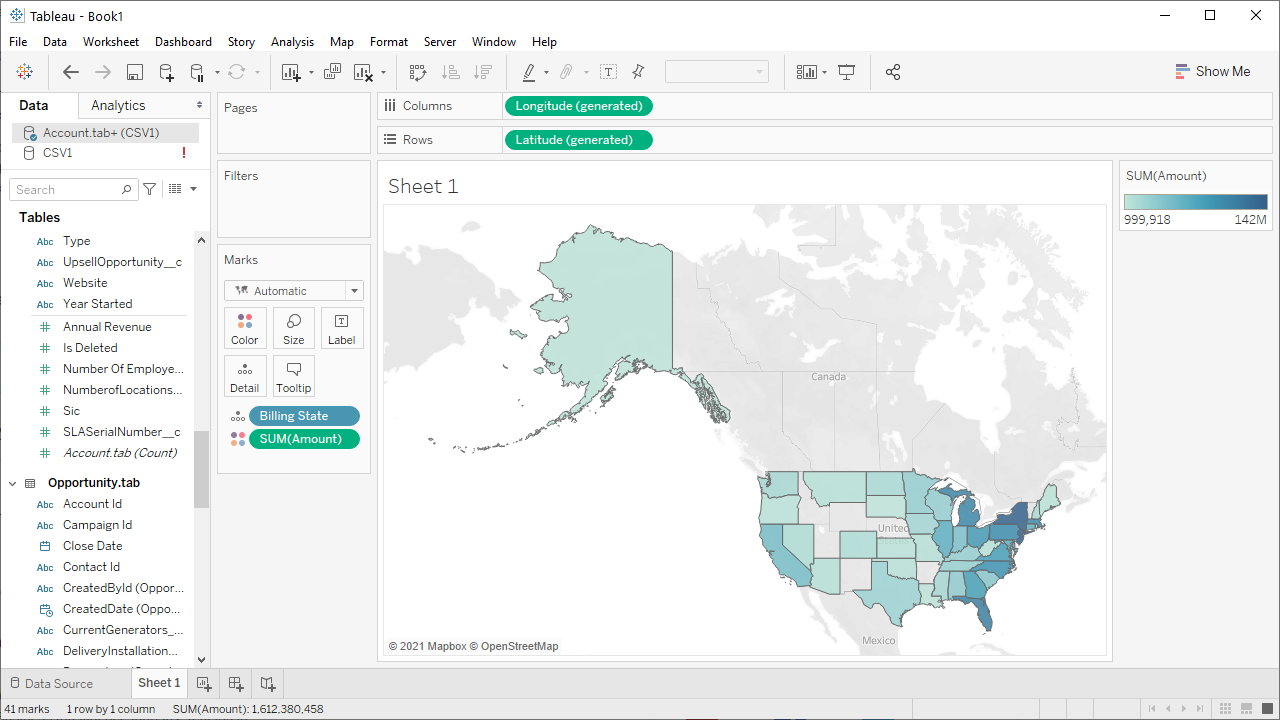Discover how a bimodal integration strategy can address the major data management challenges facing your organization today.
Get the Report →Visualize AlloyDB Data in Tableau Desktop (through CData Connect)
Create a virtual SQL Server database for AlloyDB data in CData Connect (or Connect Server) and build visualizations from live AlloyDB data in Tableau Desktop.
Tableau is a visual analytics platform transforming the way businesses use data to solve problems. When paired with CData Connect (or Connect Server), you can easily get access to live AlloyDB data within Tableau.
CData Connect Server provides a pure SQL Server interface for AlloyDB, allowing you to easily build reports from live AlloyDB data in Tableau Desktop — without replicating the data to a natively supported database. As you build visualizations, Tableau Desktop generates SQL queries to gather data. Using optimized data processing out of the box, CData Connect Server pushes all supported SQL operations (filters, JOINs, etc) directly to AlloyDB, leveraging server-side processing to quickly return the requested AlloyDB data.
This article shows how to create a virtual SQL Server database for AlloyDB, connect to the virtual database in Tableau, and build a simple chart.
Create a Virtual SQL Server Database for AlloyDB Data
CData Connect Server uses a straightforward, point-and-click interface to connect to data sources and generate APIs.
-
Login to Connect Server and click Connections.
![Adding a connection]()
- Select "AlloyDB" from Available Data Sources.
-
Enter the necessary authentication properties to connect to AlloyDB.
The following connection properties are usually required in order to connect to AlloyDB.
- Server: The host name or IP of the server hosting the AlloyDB database.
- User: The user which will be used to authenticate with the AlloyDB server.
- Password: The password which will be used to authenticate with the AlloyDB server.
You can also optionally set the following:
- Database: The database to connect to when connecting to the AlloyDB Server. If this is not set, the user's default database will be used.
- Port: The port of the server hosting the AlloyDB database. This property is set to 5432 by default.
Authenticating with Standard Authentication
Standard authentication (using the user/password combination supplied earlier) is the default form of authentication.
No further action is required to leverage Standard Authentication to connect.
Authenticating with pg_hba.conf Auth Schemes
There are additional methods of authentication available which must be enabled in the pg_hba.conf file on the AlloyDB server.
Find instructions about authentication setup on the AlloyDB Server here.
Authenticating with MD5 Authentication
This authentication method must be enabled by setting the auth-method in the pg_hba.conf file to md5.
Authenticating with SASL Authentication
This authentication method must be enabled by setting the auth-method in the pg_hba.conf file to scram-sha-256.
Authenticating with Kerberos
The authentication with Kerberos is initiated by AlloyDB Server when the ∏ is trying to connect to it. You should set up Kerberos on the AlloyDB Server to activate this authentication method. Once you have Kerberos authentication set up on the AlloyDB Server, see the Kerberos section of the help documentation for details on how to authenticate with Kerberos.
![Configuring a connection (SQL Server is shown).]()
- Click Save Changes
- Click Privileges -> Add and add the new user (or an existing user) with the appropriate permissions.
With the virtual database created, you are ready to connect to AlloyDB data from Tableau Desktop.
Visualize Live AlloyDB Data in Tableau Desktop
The steps below outline connecting to the virtual AlloyDB database in CData Connect and building a simple visualization from the data.
- Open Tableau and click "Microsoft SQL Server" under Connect -> To a Server.
- In the connection wizard, enter the values for your CData Connect instance and click "Sign In"
- Server: the address of your Connect instance and port of the TDS endpoint, separated by a comma (default port is: 1433)
- Database: the virtual database you configured for the AlloyDB data
- Username & Password: the credentials for a CData Connect user
![Connect to CData Connect from Tableau Desktop]()
- Select your newly created database and the table(s) you wish to visualize (defining relationships for JOINed tables as needed).
- Select Dimensions and Measures and configure your visualization.


SQL Access to AlloyDB Data from On-Premise Applications
At this point, you have a direct connection to live AlloyDB data from your Tableau Desktop workbook. You can create new visualizations, build dashboards, and more. For more information on gaining SQL access to data from more than 200 SaaS, Big Data, and NoSQL sources (including AlloyDB) from desktop applications like Tableau refer to our CData Connect page or download a free trial.









